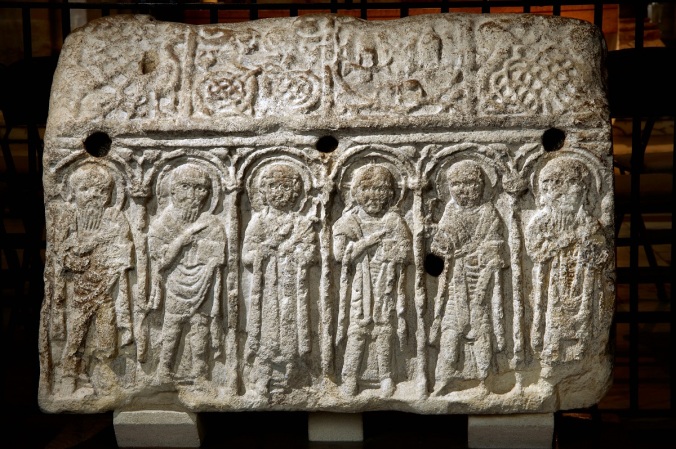Tales from Tour Guides: the stories that fascinate, perplex and inspire the Tour Guides of Peterborough Cathedral, written during lockdown.
The Hedda Stone
by Lesley Hull
The Hedda Stone is an object of great veneration and a tangible link to the first monastery in Peterborough. However, the more I read about it the more confused I become. That is part of it’s fascination for me. The date of 870 that has been carved on it is a misnomer as it has been archaeologically tested to be Roman and the Romans left Britain circa 400 AD. The only two known facts about it are that it is Barnack stone and is a solid block.

Rosemary Cramp has written a very informative chapter about the Hedda Stone entitled Anglo-Saxon sculpture of Peterborough and its Region in the book, ‘Peterborough and The Soke, Art, Architecture and Archaeology’, edited by Ron Baxter, Jackie Hall and Claudia Marx. She says, and I quote:
‘It is difficult to imagine what such a large block of stone as the Hedda monument would have been used for in the Roman period, although it could have been an unused quarry block. However she also states: ‘It is an interesting fact nevertheless that it is in Mercia, on present evidence, that we find the earliest, and most widespread evidence for Anglo-Saxon shrines, albeit in a different form, and that there is also the only textual evidence for the re-employment of Roman sarcophagi, as happened so often on the Continent.
So could it be a re-used Roman sarcophagus? It is a widely held belief that it was used as a grave marker for the mass grave of Abbot Hedda and the monks who were slaughtered by the Vikings when they destroyed the Abbey in 870 – hence its name and probably also the date that someone has carved on the end.
Its original position is unknown but it is recorded as being in the cemetery in the late 14th and early 15th centuries and also the 18th century, and it is obviously well weathered. By the late 18th century, however, it was inside the abbey.
What are the holes for? It has been suggested that the upper rows may have been candle holders, or they were used to assist in moving the stone. But had this been the case they should have been symmetrical on each side. Perhaps they were for fixing a railing around it to protect it? However there is an alternative view that if it is a re-used Roman stone the holes could have been for fixing it to a block above, which would make some sense as the Hedda figures appear to be looking down. The deeper holes could have been for the faithful to take dust from the shrine. Jonathon Foyle in his book ‘Peterborough Cathedral a Glimpse of Heaven’ says that Dr Janina Ramirez supports this view.
 Are the carvings from the Anglo-Saxon era? Rosemary Cramp states, ‘The formula seems to be that of the 5th – 7th century sarcophagi of Gaul’. She also says, ‘Any assessment of a date based on the figural sculpture is more problematic. The solemn rather static figures are remarkably classical’. Does this mean that the carvings are from the Roman era? As to the figures themselves, because they are so well weathered some are difficult to discern, but on one side we have Jesus with a cross in his halo, Mary with the lilies and Peter with his keys. One the other side John the Baptist is depicted with what to me looks rather like a punk hairstyle!
Are the carvings from the Anglo-Saxon era? Rosemary Cramp states, ‘The formula seems to be that of the 5th – 7th century sarcophagi of Gaul’. She also says, ‘Any assessment of a date based on the figural sculpture is more problematic. The solemn rather static figures are remarkably classical’. Does this mean that the carvings are from the Roman era? As to the figures themselves, because they are so well weathered some are difficult to discern, but on one side we have Jesus with a cross in his halo, Mary with the lilies and Peter with his keys. One the other side John the Baptist is depicted with what to me looks rather like a punk hairstyle!
I have recently discovered that there is a plaster cast replica of The Hedda Stone in the V&A in London dating to 1850 – 1900. It has been suggested that it might have been made for the Great Exhibition in 1851 but this is not verified. As this replica has not been weathered the carvings should be much easier see.

The Hedda Stone in the Cast Court at the V&A. Photo © Victoria and Albert Museum, London
If you are able to make a donation towards the cost of maintaining this beautiful and historic cathedral, it would help us a great deal. You can do so via the Cathedral’s Virgin Money Giving page. Thank you.